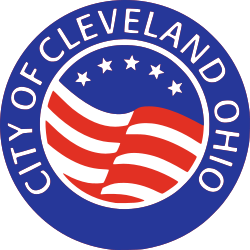City of Cleveland
- Members
Cleveland, officially the City of Cleveland, is a city in the U.S. state of Ohio and the county seat of Cuyahoga County. Located in Northeast Ohio along the southern shore of Lake Erie, it is situated across the U.S. maritime border with Canada and lies approximately 60 miles (97 km) west of Pennsylvania. Cleveland ranks as the most populous city on Lake Erie, the second-most populous city in Ohio, and the 54th-most populous city in the U.S. with a 2020 population of 372,624. The city anchors the Cleveland metropolitan area, the 33rd-largest in the U.S. at 2.18 million residents, as well as the larger Cleveland–Akron–Canton combined statistical area, the most populous in Ohio and the 17th-largest in the country with a population of 3.63 million in 2020.
Activities
Details
Cleveland was founded in 1796 near the mouth of the Cuyahoga River as part of the Connecticut Western Reserve by General Moses Cleaveland, after whom the city was named. Its location on the river and the lake shore allowed it to grow into a major commercial and industrial metropolis by the late 19th century, attracting large numbers of immigrants and migrants. It was among the top 10 largest U.S. cities by population for much of the 20th century, a period which saw the development of the city's cultural institutions. By the 1960s, Cleveland's economy began to slow down as manufacturing declined and suburbanization occurred. The city has since developed a diversified economy and gained a national reputation as a center for healthcare and the arts.
Cleveland is a port city, connected to the Atlantic Ocean via the Saint Lawrence Seaway. Its economy relies on diverse sectors that include higher education, manufacturing, financial services, healthcare, and biomedicals. The city serves as the headquarters of the Federal Reserve Bank of Cleveland, as well as several major companies. The GDP for the Greater Cleveland MSA was $138.3 billion in 2022. Combined with the Akron MSA, the eight-county Cleveland–Akron metropolitan economy was $176 billion in 2022, the largest in Ohio.
Designated as a global city by the Globalization and World Cities Research Network, Cleveland is home to several major cultural institutions, including the Cleveland Museum of Art, the Cleveland Museum of Natural History, the Cleveland Orchestra, the Cleveland Public Library, Playhouse Square, and the Rock and Roll Hall of Fame, as well as Case Western Reserve University. Known as "The Forest City" among many other nicknames, Cleveland serves as the center of the Cleveland Metroparks nature reserve system.[1] The city's major league professional sports teams include the Cleveland Browns, the Cleveland Cavaliers, and the Cleveland Guardians.

